Only if data are opened and made available to society, their real potential can be re-used to improve the existing services, optimize business processes and find solutions to corporate challenges through information analysis. In fact, according to the European Data Portal (EDP), 23% of the companies analyzed expect their turnover related to the re-use of open data to increase between 11% to 60% in the coming years, while 37% of the respondents forecast their turnover to increase by at least 61% annually.
These figures are the result of EDP's latest report Re-using Open Data: a study on companies transforming open data into economic & societal value, a new material from the pan-European initiative to understand how organizations, especially those in the private sector, re-use open data and identify the business models based on them.
Thus, with a greater knowledge about the transformation of open data into real value, the European Data Portal can make data providers better understand how open data helps adapt their data strategy and, therefore, improve the reusability of public sector information; whereas the society is shown the potential of open data by collecting real cases that use open data to generate value.
Report's methodology
First, the macroeconomic benefits of open data in the European Union were analyzed, from which the market in this sector is expected to reach 75.7 billion euros and to generate up to 100,000 jobs in 2021. In addition to these numbers, an interview was conducted with different companies from 21 countries to learn how they had re-used the open data in their services and products.
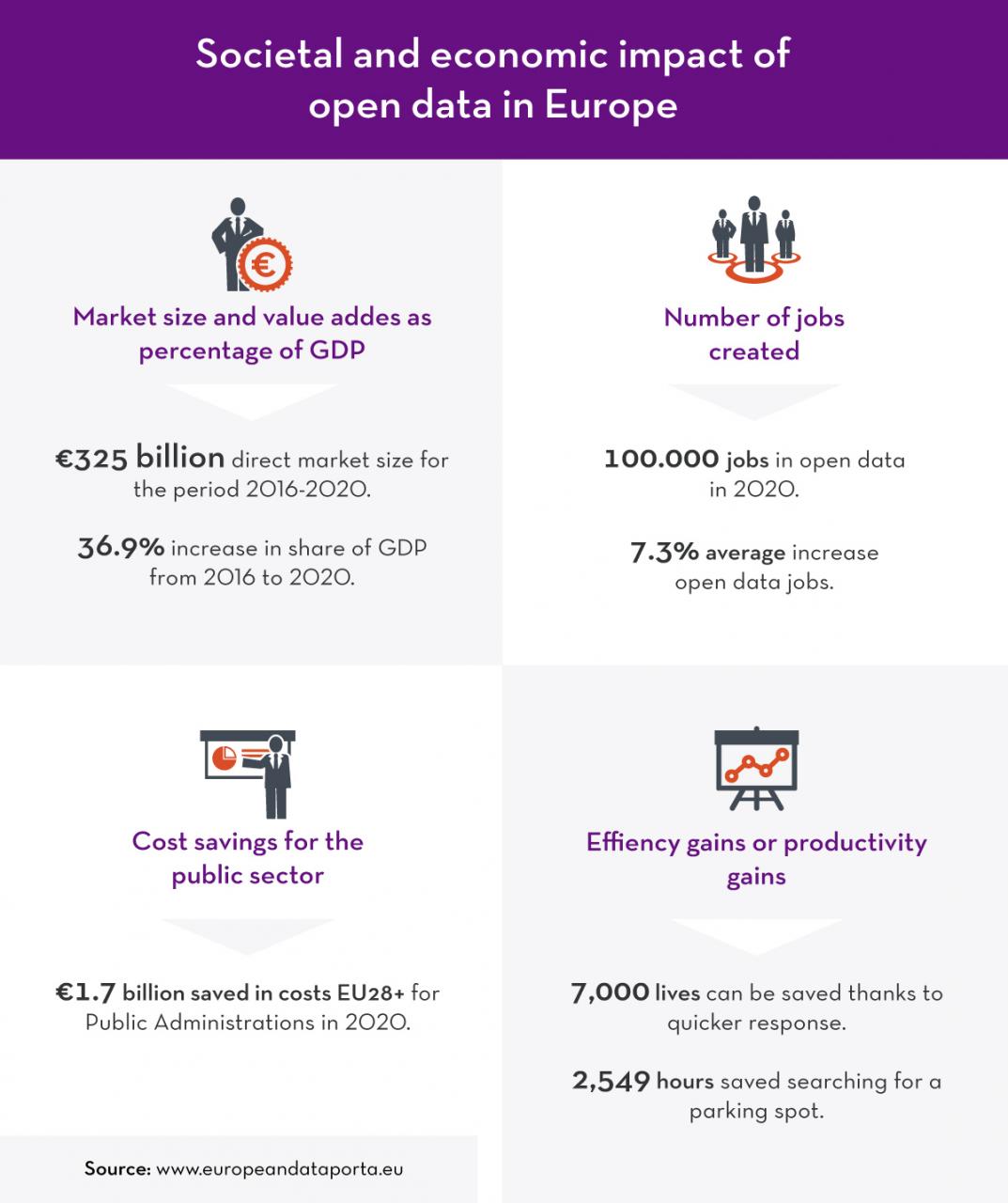
A number of entities were selected from the total sample to learn in detail their reusability experiences, the findings were interspersed with the results of a survey conducted during the last edition of the International Open Data Conference held last October in Madrid. All this added to the knowledge and experience shared by European companies through the EDP portal.
Typology and origin of open data re-used by companies
In order to understand what data categories are the most re-used by the business sector, firms surveyed had to select among thirteen sectors identified by the European Commission during the review of the DCAT application profile: science and technology, society, health, justice, government and Public sector, culture and education, environment, international, economy, transport, cities, energy, agriculture and food.
76 of the companies indicated to re-use at least one or more data categories, government & public sector (11.9%), economy & finance (11.6%), regions & cities (10.1%), population & society (9.5%), and environment (8.9%) are the five most re-used sectors, representing 52% of the total re-use of open data by the respondents.
Although the companies use data from all over Europe, and even from the USA, the United Kingdom and Spain are the most popular countries among the companies. These two nations have a greater representation in the sample given their high level of open data maturity compared to the rest of the European Union. In addition, most of the businesses surveyed claim to combine information from the public sector with their own corporate data when developing their products and services.
Business models and clients
In order to know how entities generate business based on open data, respondents were asked to indicate their source of income, concluding that 21% of them base their re-use activity on the sale of services or products (or the combination of both), focusing on two main areas: the provision of software services (41%) and consulting (25%).

In addition, the businesses surveyed were also asked to define to whom they deliver their goods or services e.g. to other businesses (B2B), consumers (B2C) or governmental organisations (B2G).The results show that there is not a clear tendency as under one third serve all client segments while more than half serve two or more client segments.
The role of open data in business models
The survey conducted by the European Data Portal included seven options for respondents to select how open data is integrated into their business models: Enhancing products, enhancing services, process optimization, data as a service, information as a service, answers as a service, development of web or mobile applications.
From all the answers, it was found that the most recurrent business model, related to the re-use of open data, is the optimization of services; using, in addition, the open data within the company with the following goals:
- Improving internal processes.
- Providing access to third party information.
- Offering services developed from re-use.
- Creating social impact from the open data.
Finally, companies have also identified the barriers to access and re-use open data, highlighting poor quality of information, lack of standardization and homogeneity, and difficulties in obtaining the data (with their corresponding metadata) suitable for their needs.
The report concludes with a set of recommendations for both the public sector which needs to better align its data publishing strategy with user requirements and the private sector which is invited to share its experience in the re-use of open data to be able to show the benefits of growth and innovation that the open data offers to the society as a whole. After all, knowing the value of data not only helps improve open data policies but it also helps other companies discover the potential of open data and join a booming sector, which will increase its market share by 37% in the coming years.
Regularly, the Ministries of Energy, Tourism and Digital Agenda and Internal Revenue Service & Public Administrations, through the National Observatory of Telecommunications & the Information Society (ONTSI), publish a report on the characterization of the Spanish infomediary sector. A document that analyses in detail the activities and impact of an industry that, only in 2015, generated a turnover between 600 and 750 million euros.
The fourth edition of this report was recently published, which collects data from 652 infomediary companies in 2015. The report deals with companies specialized in the development of apps, products and added value services based on the re-use of public and private information, data which is obtained through the review of secondary sources, including public data providers and the Trade Registry.
This is a booming industry whose volume of activity has increased 46% and, moreover, according to the information contained in the report, has grown 10% in comparison with 2014.This figure reaches 63% if the tendency is analysed since the date when the report was published for the first time, in the year 2011.
Origin of the re-used information
82% of companies in the infomediary sector re-use public information, coming almost exclusively (96%) from national sources such as the National Statistics Institute, the Official State Bulletin, the National Geographic Institute, the Trade Registry and the State Meteorology Agency, among others. In the case of foreign information, the European Union is the main data provider (69%) along with other international organizations (63%), followed by administrations outside the EU (57%) and universities (23%).
It is important to highlight the role of open data within the sector, as the number of companies re-using information in open format has increased with respect to the previous study, reaching 69% of the total. Nevertheless, 68% of the sector still has to make specific requests because the information they require is not available.
Barriers and opportunities for re-use
The re-use of information, regardless of the source from which it comes, enables the creation of value added products and services, and is a great asset to boost the economy, employment and the progress of the knowledge society, especially in the area of Smart cities and social data. Nevertheless, the ONTSI study identifies as the main obstacle to infomediary activity the lack of homogeneity of information at regional and local level, this being an additional barrier to the following demands:
● Greater proactivity in the management of the information of the Public Administration information, promoting open data by default.
● Development of ICT tools that facilitate the automation of the processes of access, refinement, treatment, enrichment and analysis of public data.
● Improved availability and quality of public data, promoting open reusable formats, interoperability and ensuring access to information.
● Promotion of public-private collaboration for the development of the infomediary market
As regards the future of the sector, companies refer to a wide range of possibilities linked to the development of products or services focussed on real-time decision-making, based on social network analysis, and data from Smart Cities, and new tools that allow the automated data management and interpretation. In this sense, the advance in the big data movement and the tools for their exploitation and support will be key elements for the future development of the sector.
This report falls within the scope of actions aimed at encouraging the openness of public sector information and favouring its re-use, one of the most relevant lines of action in recent years of Red.es, implemented through the Aporta Initiative. Thus the 2016 edition of the Report on the Infomediary Sector Characterization provides greater knowledge about the activity of this industry, incorporating new aspects compared with previous documents by performing a systematic analysis of the sector, regardless of the origin of the re-used information, and including a set of good practices of infomediary companies from which recommendations can be made that help other projects in the sector.

According to the data provided by the European Commission, the re-use of big data in the 23 largest EU countries could reduce administrative costs by 15-20%. In addition, the re-use of public services by other administrations, companies and citizens makes possible the development of personalized and innovative services adapted to the needs of the population. After all, the use of digital technologies as an integral part of government strategies entails great economic and social benefits for Europe as a whole.
Aware of this, the European Commission approved last year the Action Plan for eGovernment 2016-2020, which aims to modernize public administration with ICTs, enable cross-border mobility with interoperable digital public services and facilitate digital interaction among the Administrations and citizens/companies to have high quality public services. In support of this plan, a report has recently been published which provides an overview of the initiatives related to open and collaborative government in the European Union, which aims to provide advice on how to make the new eGovernment Action Plan more open while citizens are invited to participate in the process.
This report consists of four main sections. First, it includes an analysis of the current open government ecosystem in Europe according to the definition shown below. To this end, approximately 400 of the existing initiatives have been studied in detail. In addition, this initial section compiles a set of best practices on government issues and identifies the digital catalysts as well as the fourteen barriers that hinder this progress.

From all this information, the report concludes that nowadays all EU member states have open government practices, most of them carried out by the public administrations of each country, covering all government sectors. However, most practices are related to the openness of public services, including open data portals or programs aimed at improving interoperability among the different public administrations. And to a lesser extent, with the openness of the political processes that suppose a greater commitment, citizen participation and transparency.
Then, a set of 13 recommendations for an effective policy mix to increase open governance practices across Europe is included; all structured according to the following high-level political objectives:
- A more transparent functioning of government.
- Better policy making via enhanced participation.
- Better (digital) public services via enhanced collaboration.
- Unlocking the economic potential of government assets.
- Supporting the update of open government in general.

The third section of the report includes a methodology to support the processes included in the Action Plan, including the mechanisms and tools necessary for stakeholders to share and discuss their needs with the Administration through the Futurium-eGovernment4EU consultation platform.
It is important to note that the methodology involves collaboration among the European administrations at regional and national level, which will result in the exchange of experiences, good practices and lessons regarding eGovernment. Finally, the methodology offers recommendations for the assessment of the eGovernment Action Plan, enabling the establishment of objectives and their evolution year by year.
As the finishing touch, a report on the design of a participation and communication plan that describes how to inform different stakeholders and raise awareness to bring them to the consultation platform is included.
Under the heading "Towards faster implementation and uptake of open government", this document calls for a more transparent proceeding of the government; a greater participation in the development of effective policies and a closer collaboration to improve digital public services.
This would require to apply a single principle, the use of ICT standards and specifications as well as open methodologies for the design of collaborative public services and the construction of shared infrastructures for reusable digital services based on open standards. In this way, it would be possible to unblock the economic potential of government assets and support new data ecosystems that also increase the acceptance of open government in general.
There is increasingly more information, to such extent that the current society lives surrounded by data. Nevertheless, one of the most common criticisms of this mass of information is its lack of usability. It is not only a matter of publishing data on the web, but we should focus on their treatment, re-use and consumption by the end user. Only when we approach them and apply an interpretation they make sense and become knowledge.
In this technological context, data exploitation has evolved in the last decades to design interpretation mechanisms that are increasingly robust and affordable. And among these exploitation mechanisms, the most important is data visualization.
In this framework, Iniciativa Aporta has elaborated the report “Data visualization: definition, technologies and tools”, a handbook based on the analysis on two distinct but complementary aspects. On one hand, the visualization technologies are explained in detail as frameworks and coding libraries that allow the construction of applications and data based services; including exclusively the cutting-edge web technology and especially that which is built on standards, such as HTML5 (Canvas), SVG and WebGL.
On the other hand, this documents takes a journey through the available visualization platforms, analysing the applications that allow the construction of dashboards and comprehensive interactive visualizations. Those platforms that are more web-oriented and can be applied to the exploitation of open data, those coming from the world of BI and data analysis, are presented in detail: Tableau Soft, Qlik and Tabulae. Or, failing this, open data publishing tools that incorporate certain features of visualization: CKAN and Socrata.
Currently the number of tools and platforms for data visualization that can be accessed is very extensive. Thus, this report includes together with these instruments a set of real examples, some of them more closely linked to the data analysis and visualizations, whereas others provide support to data publication, which add to their functionality capabilities of graphic representation of data for their consumption.
In order to help in the treatment of such information and transformation into more readable formats, the report includes seven examples of data visualizations, from public sector and independent entities both national and international. It concludes analysing future trends on data treatment: Visualization and large volumes of data, visualizations that can be built by the end user and the development of 3D visualization technologies.
Nowadays, visualization is a powerful tool to discover and understand the logic behind a dataset, open or not, and to share this interpretation with others from an objective point of view. For this reason, this report is an opportunity to show to stakeholders of the national open data community the way to treat and transform the raw material into a useful resource for any purpose.
The open data contribute to the political, social and economic sustainability of a country. The European Commission, aware of the value of the re-use of the public sector information for the eurozone growth, tracks regularly the state members in order to asses the progress achieved in their open data policies.
In this way, at the beginning of the year, the European Data Portal published its first report on the assessment of the maturity of the open data ecosystem: a detailed document where the results obtained by the EU28+ in 2015 are shown. Nevertheless, according to the monitoring performed by this initiative, the second edition of this study has been published, which shows the updated data from 2016 in comparison with the previous year.
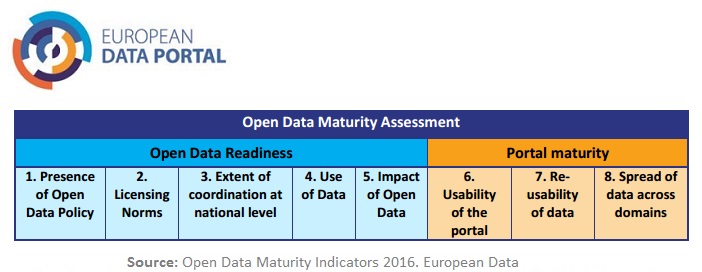
The measurement is built on two key indicators Open Data Readiness and Portal Maturity, thereby covering the level of development of national activities promoting open data as well as the level of development of national portals.
According to the document’s data, in 2016 the 31 countries assessed in this report progressed by 28.6% in comparison with the results obtained in 2015. In fact, all the nations have completed over 55% of their journey towards the openness of public sector information, showing that they have successfully developed a basic approach to address open data policies. However, significant discrepancies across countries still exist. Though some countries are still in the process of creating a national open data portal, other countries have already launched new initiatives and are redefining their multiannual strategy.
This reports has been accompanied with an interactive panel, published on the European Data Portal, which shows the results of the key performance indicators that assess the open data maturity. These KPIs include the level of development of the national open data policies, an assessment of the available characteristics in these platforms, as well as the expected impact of the open data policies.
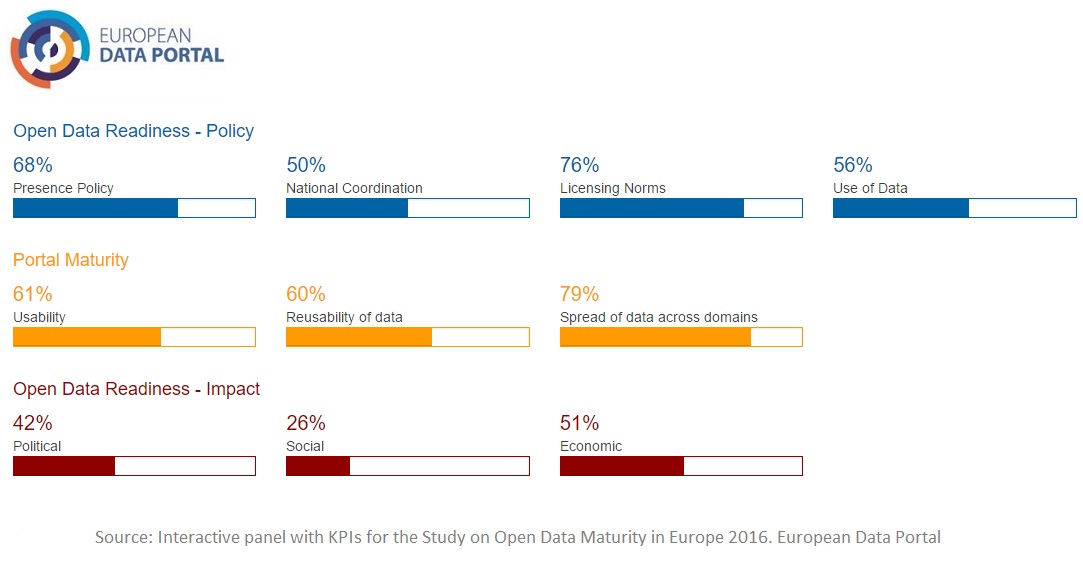
This online dashboard includes the information classified by country to help the user compare the existing differences in the openness of public data in the European Union. In this way, it is possible to create slides for each state member (together with Norway, Switzerland and Liechtenstein) to know all the details as regards their initiatives, catalogues, barriers, best practices, achievements and next steps.
Thanks to the analysis and summary done by the European programme, it is possible to know that Spain is in the first position in the EU, leading the ranking of open data maturity (as shown in the next figure), due to the high scores obtained in the different indicators: norms, policies, national coordination, portal usability, re-use or availability of the open data.
The greatest progress obtained by the country in comparison with 2015 has been the significant increase of open data impact, especially in the economic field. In fact, Spain scored the maximum of 120 points from 90 points scored in the previous year. It should be highlighted that only two countries have been identified as very ready, these are France (84.4%) and Spain (92.2%). Moreover, this last has done a great work to measure the social impact of open data, scoring the 100% of the possible points.
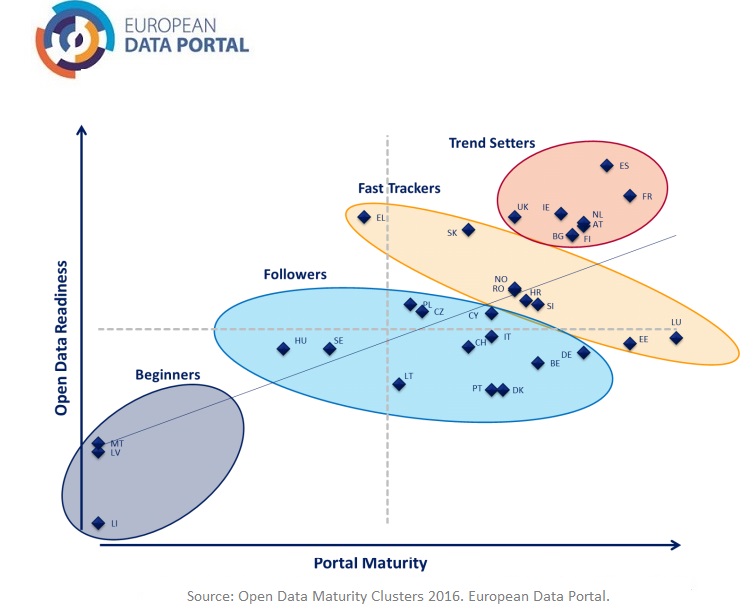
Although the benefits of open data are already widely known as they have become an important resource to increase citizens' access to information in the public or private sector, and promote economic growth, scientific research and corporate accountability, concern grows when the open publication may damage the privacy of the individuals and violate the current legislation which prohibits the release of personal information.
There are methods to open up the information in a way that the data anonymity is preserved, however there are certain risks in the process. For this reason, a successful and sustainable open data programme should be guaranteed, based on three pillars: Morally, the data publisher should consider the privacy of data subjects; legally, data protection law must be respected and pragmatically, public confidence has to be maintained.
In this context, the European Data Portal has published the report "Open data and privacy", a new document carried out by the pan-European initiative to promote the re-use of data whereas data protection is respected.
Compiled from interviews with experts in the field and the analysis of the reform of the EU Data Protection rules, this document explains in detail the concepts of privacy, personal data protection, dissociation and re-identification of data at the same time it explores and shows governments how to publish information while the individual data are dissociated.
Moreover, the different phases in the open data lifecycle are shown, from collection to final follow-up, explaining what each of the stages consists of and how it is possible to maintain the anonymity of open data and not to violate privacy during the opening up and re-use process.
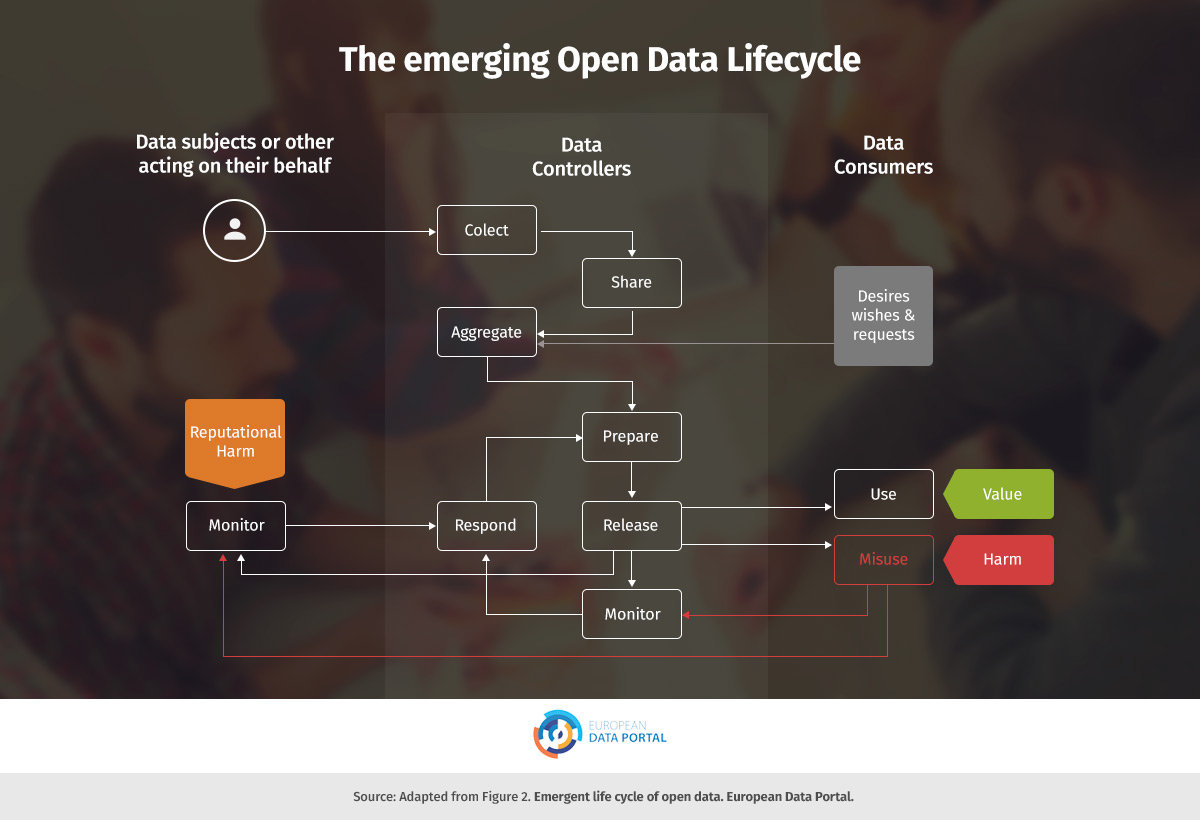
To conclude, this report includes eight general recommendations for a data controller or an organisation that was considering making datasets that have been derived from personal data open:
- Understand the data. Consider potential use cases, and the value of the data. Identify stakeholders. Consider the effects on stakeholders of making it public.
- Consult. Engage stakeholders about the publication programme. Key stakeholders include data subjects, potential consumers, domain experts, internal data controllers, and technical advisors. If consent for data releases can be obtained, then try to obtain it.
- Three pillars: privacy, data protection and public confidence. By law, a data controller has to obey data protection legislation. But morally, the controller should consider subjects’ privacy, and retaining public confidence is essential for the sustainability of an Open Data programme.
- Publication. A decision to publish personal data should be made only on the basis of a strong case in law.
- Anonymity. Follow guidelines for anonymising personal data as the ICO (Information Commissioner’s Office) code of practice.
- Utility. There is no point publishing data which has been denuded of serious content. Ideally, anonymisation will go far enough to reduce the risk of identification while retaining sufficient utility to meet the needs of data consumers.
- Follow-up. Anonymisation and Open Data demand responsible data stewardship, including monitoring the context in which the data is likely to be used.
- Crisis plan. Have a plan in place in the event of a problem.
This report is published only a few months after the entry into force of the reform of EU Data Protection rules. With this new material, the European Data Portal helps public agencies and private entities immersed in open data initiatives comply with the new rules intended to ensure throughout the European Union high standards of protection of personal information, adapted to the digital environment.
The state members have two years to amend their national legislation according to the latest European directive. Thus, in Spain, the current law 37/2007 on Reuse of Public Sector Information, which was already renovated in 2015, will have to be adjusted once again to give citizens more control over their data and ensure that their privacy is well protected in the digital area.
Beginning in February 2013, the World Wide Web Foundation, with support from IDRC (Canadian International Development Research Centre) leads a research driven project entitled "Exploring the emerging impacts of Open Data in the developing country" (ODDC). During thirty months, the goals of this initiative are exploring how open data improves governance and strengthens civil rights; promoting the knowledge sharing and policies learning; developing and testing open data initiatives and investigating how standards, platforms and open data infrastructures impact on the re-use of open data in developing countries.
The initial phase of this project (ODDC1) was implemented through a seed funding granted by IDRC, part of the Open Data 4 Development network, and formed by seventeen grants to partners from 12 countries to carry out investigations in the field of governance and open data. In 2014, these projects were assessed to analyse the short term impact of these activities on the entities and the international open data policies.
Since the publication of the evaluation report, continuous, significant and positive outcomes have been obtained from the initiative such as, for example, the network created around the ODDC and formed by a large number of experts, developers and open data advocates from developing countries. However, the biggest change throughout all this time has been the great impact of the project on the open data policies and practices; improving the understanding of open data culture in the world and influencing the role of open data in the sustainable development of the poorest countries. In fact, the participating nations have begun to notice a change in the open data attitudes and policies; opening the door to new achievements in the future.
Methodology and findings after the initial phase
In order to measure the progress achieved in the first phase of this initiative, all research partners were surveyed electronically on key questions and follow-up interviews were conducted with 5 former research partners and two external experts; drawing the following conclusions:
- 74% of the partners claim that policy makers and other government actors have shown an increased understanding of open data and related concepts (like Right to Information).
- 60% of research partners surveyed have started working on other open data projects since joining ODDC and 74% of them have been establishing new alliances with third parties in OD field.
- 84% of organisations could identify cases where the ODDC research was being reused by others. It is still early days for measuring the spread of the research through academic outputs, however there is evidence of some of the papers beginning to be cited more widely in academic research.
- Before ODDC, the 75% of partners had very little or no knowledge of open data, now three quarters say they have significant experience in the sector.
- 83% of the partners feel that they are recognised by others as experts in the open data field, either in their national context or globally.
Thanks to this type of research projects, not only a positive change is made in local and regional open data tendencies, but journalists, companies, public officials and citizens may understand the meaning and benefits of the open data movement. Thus, it is possible to keep making progress in policies and programs that build a solid open data environment in those countries which are less developed in the release of public sector information.
Iberinform is the information subsidiary of Atradius Crédito y Caución, a leading company in the world of credit insurance with a direct presence in over 50 countries.
We help companies identify business opportunities and potential delinquency risks. Our advanced analytics solutions and predictive algorithms facilitate commercial decision-making, providing practical and useful information for marketing, finance, and sales departments.
They transform business data into information and knowledge through tools that facilitate business processes and decisions. Primarily, their sources of information include 500,000 interviews per year with companies, the commercial register, and other public sources. Their business information service allows access to reports on 322 million companies in 72 countries and provides access to the largest files of Spanish banking delinquency, such as RAI and ASNEF Empresas.
This platform offers databases that help identify new clients and tools that facilitate risk management, analysis, and monitoring of clients, suppliers, or sectors. In addition to providing its online services, Iberinform also has twelve offices in different locations in Spain and Portugal.
ASEDIE (Multisectoral Information Association) has published its report in which components, market behavior and characteristics of infomediary sector in Spain are analysed. To carry out this study, the entity has identified and analyzed 602 infomediary companies (21 companies less than in the previous edition) -firms that re-use public/private sector information to develop products or services for the whole society- classified into nine segments: culture; directory services; economic and financial; publishing; market studies; geographic information; weather; tourism and others.
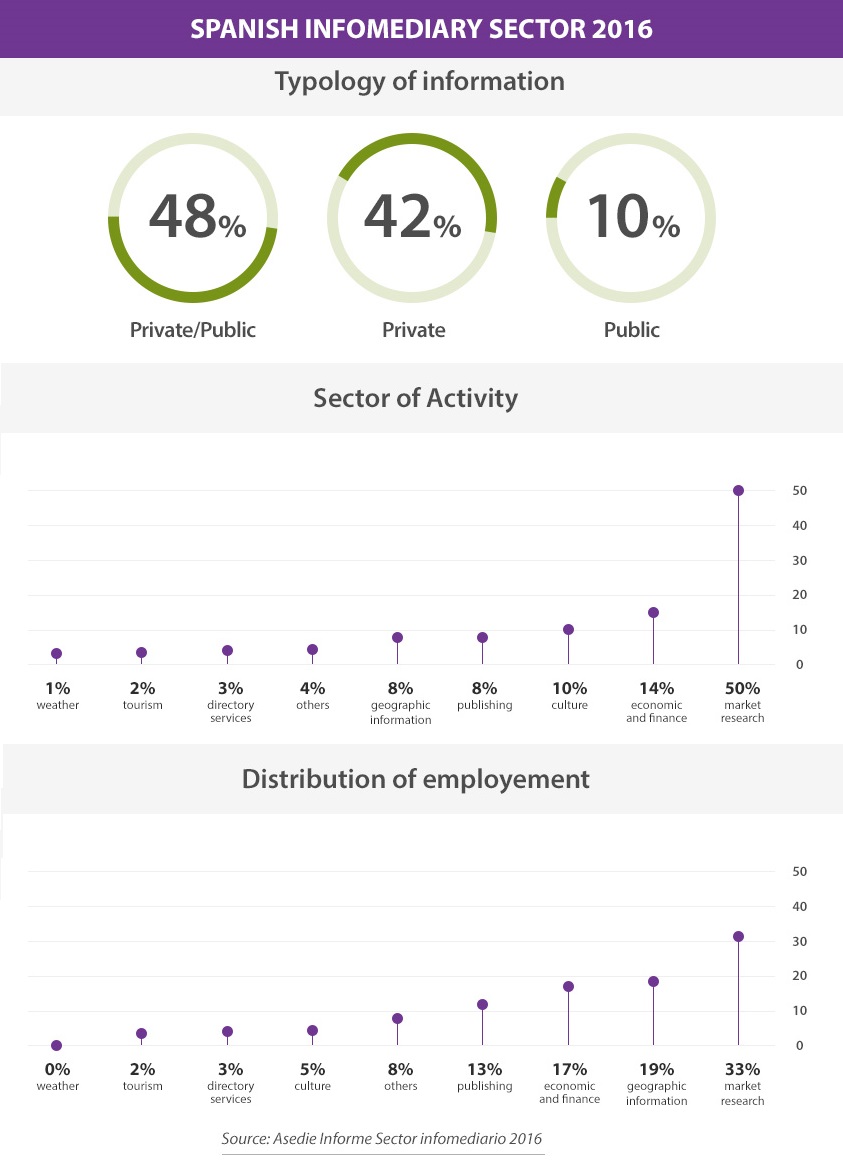
Located mostly in the Community of Madrid and Catalonia, 50% of the evaluated companies belong to the market research area, as previous years, followed by financial entities with a 14 per cent and cultural institutions with a 10 per cent. The less representative sector is the meteorological industry, which covers only 1% of the total.
Analyzing the origin of the type of information, 90% of the infomediary companies operate with private information (42% only "private" and 48% "public and private"), and 58% of them use public information (10% only "public" and 48% "public and private").
Total revenues associated with the infomediary companies in 2014 were close to 1,400 million euros compared to 1,000 million in 2013. This figure allows to assign average revenue of 2.27 million euros per company; concentrated in four groups: market research, economic and financial, geographic information and publishing. In addition, the number of employees in this sector during that year exceeded 15,000 workers, decreasing 3.2% from the previous report.
Nevertheless, a sign of the remarkable evolution of national infomediary sector is the 6.6% growth in sales in comparison to the previous year, a positive evolution if we take into account that the turnover for 2013 had dropped 2% in sales.
Moreover, the assessment methodology of this last reports has been slightly modified, adding three new types of analysis: two of them based on the evolution of the companies included in previous reports and the third divides the companies into five sections according to their commercial risk exposure and their probability of default. In this regard, 77% of the infomediary companies are included in the group of low-moderate risk, 19.6% of them are included in the high-maximum level and, finally, 3.5% of the companies are defaulting.
Thanks to the study and its evolutionary analysis of the last four years, ASEDIE report shows us that information is an important and essential resource for socio-economic growth in Spain; allowing the assessment of impact, relevance, qualities and influence of the sector at national level and the comparison with other geographical areas.